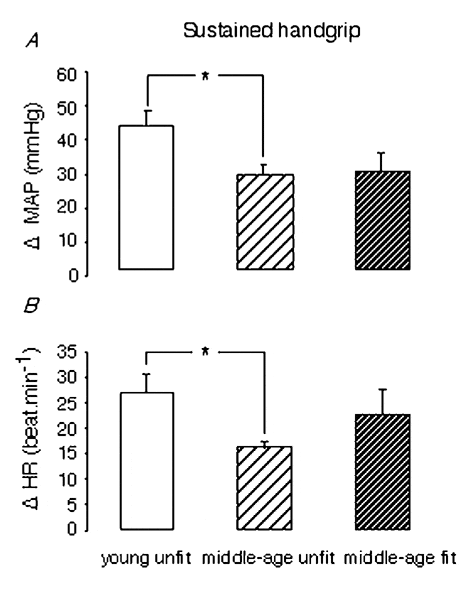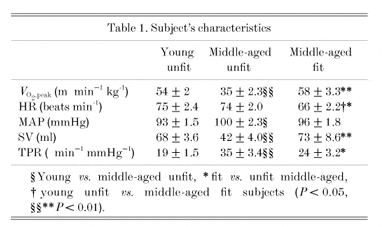Ageing increases sympathetic drive and reactivity (Barnes et al. 1982), while exercise training in young subjects reduces sympathetic drive and causes non-specific blunting of sympathetic activation (O’Sullivan & Bell, 2001). Few studies have investigated whether training in an older population attenuates the increase in sympathetic activity (Seals et al. 1994).
Young unfit (n = 11, 23 ± 0.8 years, mean ± S.E.M.), middle-aged unfit (n = 8, 53 ± 2.0 years) and middle-aged fit (n = 9, 49 ± 2.1 years) subjects were recruited. All gave informed consent and experimental procedures were approved by the local ethics committee. Subjects were instructed to refrain from caffeine, alcohol and exercise for 12 h before tests. Applanation tonometry and impedance cardiography were used to measure mean arterial pressure (MAP), heart rate (HR), stroke volume (SV), cardiac output (CO) and total peripheral resistance (TPR) at rest and during a sustained handgrip at 50 % maximum voluntary contraction to fatigue, 2 min mental arithmetic and 1 min immersion of the foot in iced water.
At rest, MAP and TPR were greater and SV was reduced in middle-aged unfit (Table 1). Middle-aged unfit subjects had a smaller increase in MAP in response to isometric exercise (Fig. 1, P < 0.05, Student’s unpaired t test) and cold exposure (6.7 ± 1.9 cf. 22 ± 3.9 ▓Dgr│mmHg, P < 0.01) (Fig. 1). The HR increases to isometric exercise (Fig. 1, P < 0.05) and mental arithmetic (8 ± 1.9 cf. 17 ± 3.2 ▓Dgr│beats min-1, P < 0.05) were reduced by ageing. During all tests, SV and CO were lower in middle-aged subjects, and TPR was increased.
Physical fitness appeared to reverse age-related changes in resting cardiovascular parameters (Table 1). MAP responses to stress were similar in fit and unfit middle-aged subjects. However, HR, SV, CO and TPR responses in middle-aged fit subjects were not different from those seen in young subjects.
This study does not support the notion that ageing is associated with sympathetic hyperreactivity. While physical fitness appeared to reverse age-related increases in MAP and TPR, it did not cause blunting of sympathetic activation. However, the diminished ability of middle-aged subjects to reflexly increase HR was improved by regular aerobic activity.


